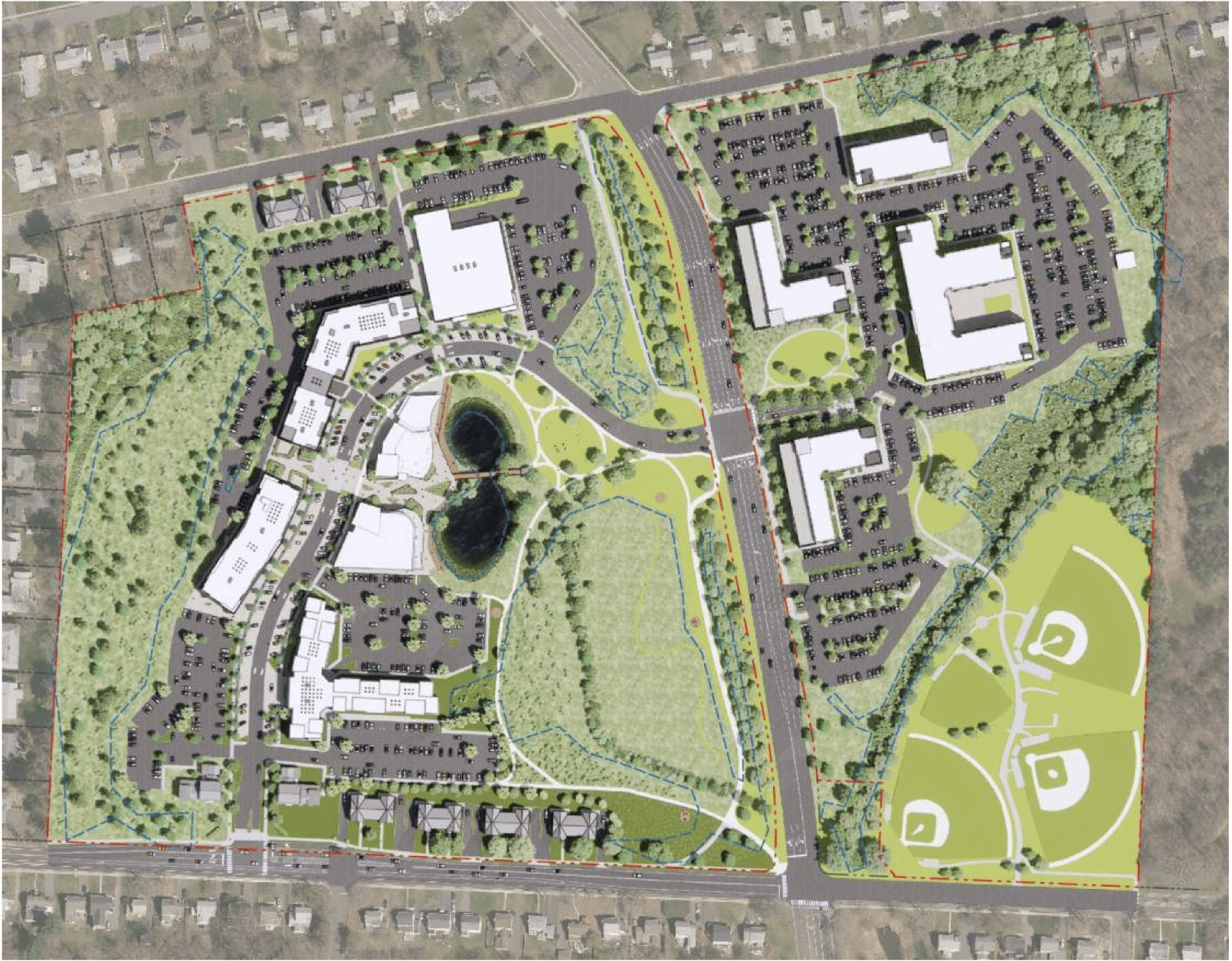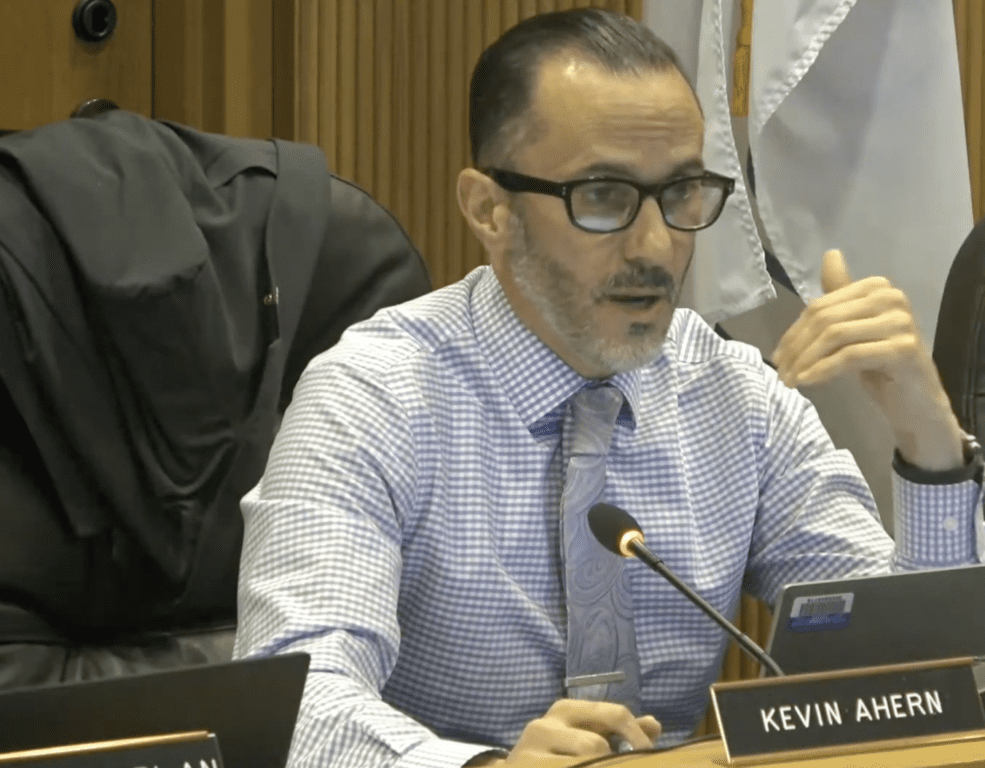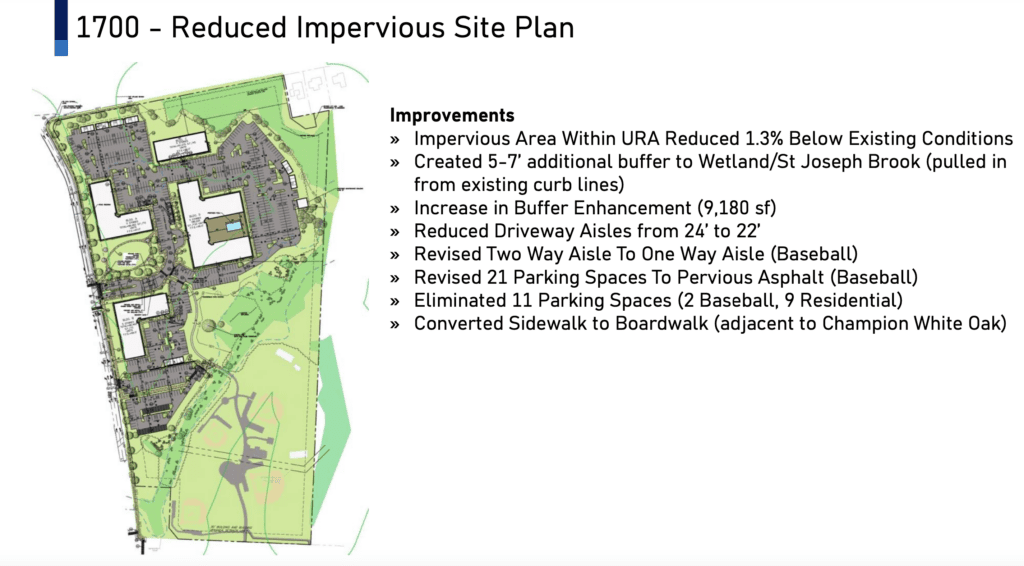What’s Next for Former UConn West Hartford Campus Wetlands Proposal

Audio By Carbonatix

Site plan for Oakwood Park, Dec. 13, 2023. West Hartford 1 LLC presentation
West Hartford’s Town Plan & Zoning Commission, in its capacity as the Inland Wetlands and Watercourses Agency, held the third and final hearing on 1700 Asylum Avenue on Dec. 13, 2023.
By Ronni Newton
West Hartford’s Town Plan & Zoning Commission (TPZ) met for roughly 15 hours – in three separate installments – to consider the wetlands applications for by the developers who would like to construct Oakwood Park on the former UConn campus at Trout Brook Drive and Asylum Avenue in West Hartford, and a decision on at least a portion of the application will be rendered when TPZ next meets.
That vote will likely take place on Jan. 3, 2024.
Also likely to take place in January will be the re-start of consideration of the wetlands application for 1800 Asylum Avenue – the western portion of the former UConn campus where several buildings must also be demolished and PCBs and other environmental hazards remediated.
Unless wetlands applications are approved, neither TPZ nor the Town Council will have the opportunity to consider any proposal by the developer for rezoning and creation of a Special Development District for Oakwood Park.
TPZ, in its capacity as the Inland Wetlands and Watercourses Agency (IWWA), had scheduled a hearing to consider applications submitted by the development group West Hartford 1 LLC, through the entities WEHA Development Group LLC and WEHA Development Group East LLC, for both 1700 and 1800 Asylum Avenue. The complexity of the wetlands review for the entire property– which involves roughly 57.4 acres, of which 42.9 are regulated as either wetlands or within the 150-foot upland review area where there could be direct wetlands and watercourses impact – and the myriad questions and comments by town staff and a professional soil scientist working with the town, led to the start of the hearing being delayed multiple times to ensure that all issues would be given proper attention.
By the end of the first roughly four-hour hearing on Nov. 29, it was clear that the scope of information to consider, questions that needed answers, and testimony to review was even more extensive that anticipated and would take at least several sessions. During that first hearing TPZ was only able to receive a presentation and ask questions of the developer regarding the 1700 Asylum application, which is the east side of the property – currently a large asphalt parking lot and ballfields/playground – where the developer would like to construct four residential multifamily buildings of four or five stories. There was also cross-examination permitted by intervenors who had filed a petition that was accepted that night. When the hearing was suspended around 11 p.m. and continued to Dec. 11, TPZ had only had the chance to hear from a handful of members of the public.
TPZ met again on Dec. 11, and during a six-hour marathon that night heard more from the developer, the intervening party, and from many members of the public.
TPZ was statutorily required close the hearing by Dec. 15 because hearings can only remain open for a certain period of time. The only other option was to begin the entire process of submitting the application and scheduling a hearing all over again. Once the hearing is closed, TPZ Chair Kevin Ahern said the Commission has up to 65 days from the time the hearing is closed to render a decision.

TPZ Chair Kevin Ahern speaks at the Dec. 13, 2023 public hearing on the wetlands application for 1700 Asylum Avenue. Screenshot from WHCi YouTube video
After Part 3 of the hearing concluded around 11 p.m. on Dec. 13, TPZ members acknowledged that not only was it late at night, but there were also some last-minute changes made to the application earlier in the week and additional materials remaining to carefully review, so the decision was made to adjourn and take up the vote on 1700 Asylum at a future date.
Prior to the Dec. 13 meeting, the development team had also withdrawn the application for 1800 Asylum – the larger portion of the 57-plus-acre property, and the area where the developer would ultimately like to construct 14 buildings, including a 117-assisted living facility, 24 townhomes, and 106 apartments in two mixed-use buildings above retail or restaurants. The plans also include a premier restaurant, a destination spa, and an organic grocery store. That application is expected to be resubmitted in early January and set for hearing as soon as late January – starting the process all over again.
According to Town Planner Todd Dumais, the last-minute changes to the application were primarily in response to staff questions or comments from the public, and most of the changes center on requests to reduce impervious coverage, increase buffers along wetlands, and some changes to pavement typing. “These are achieved largely through reduction of drive aisle widths, reduction and elimination of parking, and a change of parking surface type to a previous surface in limited areas,” Dumais said.

Excerpt from applicant’s presentation of wetlands application for 1700 Asylum. Town of West Hartford website
Matthew Bruton of BL Companies, a professional engineer and member of the West Hartford 1 LLC development team, presented the changes and outlined the ways in which the impervious areas have been reduced by 1.3%, and how an additional buffer of between 5 and 7 feet was created along St. Joseph’s Brook. He said the drive aisles are still adequate at 22 feet, and revising a two-way aisle to one-way also eliminates pervious surface. Some of the surface for baseball parking has been converted to pervious surface which is possible because the use is seasonal and that area can also be used for snow storage.
“We’ve converted the sidewalk adjacent to the champion oak to boardwalk,” Bruton added, in response to concern that a regular pathway might damage the tree. He said the plan was reviewed by an aborist, who is supportive of the plan and will be present during the construction of the boardwalk.
Regarding tree demolition, Bruton said, there are 517 existing trees. Of those, according to the latest plans 133 trees will be cut down, but 329 will be added in the upland review area and 422 will be added on the parcel as a whole, bringing the total number of trees to 939 post-development.
Attorney Robin Pearson of Alter & Pearson, also a member of the development team, said the environmental impacts of the activity “are frankly all positive” with the only direct impact related to an existing outfall to St. Joseph’s Brook that will be improved. “Clearly water quality is going to be improved if this application is approved,” she added. Surface water from the parking lot is currently untreated.
Pearson said the overall wetland mitigation “will clearly enhance the function and the environmental health of the riparian corridor.” She said the proposal is “truly a rescue story for these wetlands and St. Joseph’s Brook itself,” and will not increase flooding in the area.
TPZ Commissioner Gordon Binkhorst asked if any other designs had been considered as “feasible and prudent alternatives” to the current proposal. Bruton said it had changed significantly from the original proposal.
The intervening parties – Christine Feely, Jessica Rubin, and Gary Schulman – also had the opportunity to present material and ask questions of the development team.
Rubin asked if the soil under the existing parking lot had been sampled to determine if there is wetland soil beneath there. Dean Gustafson, a professional soil scientist with All-Points Technology who is also part of the development team said they “do not do investigation of developed areas because they are not considered regulated resource areas.”
Feely expressed concern that engineered systems for wetlands management can fail, and current recommendations are for expanding wetlands. The existing parking area, she said, would likely never have been built. “We don’t really know what will happen if we rely too much on engineered systems,” she said. She added that the developer “could have worked with the characteristics of the site instead of against them.”
Feely said there also needs to be more attention to plant and wildlife. New trees will take decades to reach the size of existing trees that are being removed, she said.
Schulman said he and the 0ther intervenors understand that the developer has met engineering standards and 100-year flood standards. “I think we just have to stand back and consider … the willingness of the applicant to maximize construction of buildings and pavement in the upland review area and then engineer the heck out of this project.” The town says it has a sincere commitment to sustainability, he said, “and I’m wondering if this is time for the rubber to meet the road.”
Members of the public, including some who had commented previously, also spoke during the hearing on Dec. 13.
Resident Jay Costello said they are planning to completely disturb the uplands review area, which is regulated area. UConn was allowed to disturb the entire site, he said, urging TPZ to take a look at the big picture of what the developer is proposing. “The current proposal is not the most prudent and feasible alternative,” Costello said.
Resident Beth Ann Loveland Sennett said the proposal on 1700 should be delayed until the impact of increasing precipitation rates can be incorporated. “Also because currently there are no structures on this property and the deteriorated parking lot is a fairly permeable surface, the parking lot is absorbing a lot of water right now,” she said.
“The claim of adding more trees is only after removing hundreds of old oak growth trees which are consuming gallons of water,” resident Martha Parish said, noting that sometimes regulators have to make a hard call. She said the photos of the replacement trees are “deliberately deceiving” and depict the tree height in about 20 years.
Stormwater management is needed to make up for natural management, Parish said, putting water rapidly into the storm drains which can cause flooding and bank erosion.
“We want a scaled back proposal that prevents the destruction of trees particularly in the wetlands and URAs [upland review areas], we want no more impervious surfaces built on any of the wetlands and URAs whatsoever. … Just because a mistake was made in the 60s by paving east of Trout Brook does not mean we perpetuate that mistake again,” urged Parish.
Morgan Hilyard, a Lawler Road resident, said she is currently seeing many flooding and drainage issues on her property. She expressed concern with standing water issues and other issues related to an abandoned parking lot where people teach their kids to drive – and also do doughnuts. There are also a lot of dead and rotting trees, she said, and litter.
“What I’ve seen from this presentation is a remarkable and innovative way of looking at what we currently have and what we’re dealing with, and how to address concerns from residents and how to manage that in a prudent way,” Hilyard said. She said the area is not currently maintained and “it is under stress.”
Hilyard said she agrees with the experts that say wildlife, aquatic life, and plant life will benefit from the improvement to the property – and that will also remedy the eyesore that is an abandoned parking lot.
In closing statements, Bruton noted that the project has been in design for two years, responding to voiced concerns by some residents that the process is being rushed.
Pearson said the development will not provide downstream deleterious impacts. Discussions of traffic and other issues are for discussion at another point, she added. “We have been asked to slow down this application,” she said, but 1800 was always a separate application and subject to separate analysis.
“The intensity of the development on the site itself is not what you are looking at when you decide this application,” Pearson said. She said she feels the comments that have been raised have been addressed.
Ahern said Jan. 3, 2024 is the next regular meeting date for TPZ, and in closing the hearing he gave Commission members the option to adjourn or deliberate.
Commissioner Liz Gillette said there was new material received Wednesday night that required further study, “and it would be a disservice not only to the applicant but to the public and ourselves to make a decision at this time of night on something so large.”
Like what you see here? Click here to subscribe to We-Ha’s newsletter so you’ll always be in the know about what’s happening in West Hartford! Click the blue button below to become a supporter of We-Ha.com and our efforts to continue producing quality journalism.



